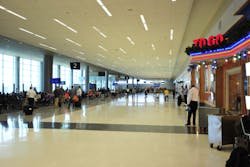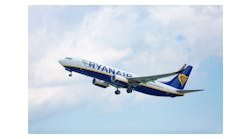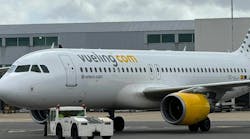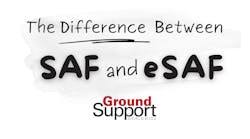The message from Bob Montgomery — Southwest Airlines’ vice president of airport affairs — in a keynote address at April’s AirIT conference was clear: airports are not going to get between him and his customers.
Montgomery started at Southwest 39 years ago as a part-time worker. “When I walked in the door at Southwest in late 1977, airlines and technology rarely collided in the same sentence. We were a low-cost airline,” he said. “Just to give you a picture of what things were back then, if you were using a phone, it was about 20 times bigger than it is today and it was attached to the wall. You couldn’t leave a message because there weren’t answering machines.”
Southwest needed to build a reservation system, said Montgomery. “We were cheap we didn’t want to buy the huge computers that were required at the time, so we bought Bunker Ramo machine, a stock quotation machine that Wall Street was getting rid of,” he said. “The screen was about a third of the size of my iPhone, just a little bitty screen that had nothing but the flight number and a passenger’s name.”
The airline didn’t have actual tickets; it had an NCR cash register that created a receipt, said Montgomery. “Instead of a boarding pass, the receipt would repeat the same information on the top and the bottom. And to give somebody a boarding pass we just tore their ticket and gave them the other half,” he said.
“We have thousands of employees that are dedicated to nothing but technology solutions across our enterprise. We also have thousands of contractors who help us accomplish the technology agenda of Southwest Airlines,” Montgomery said. “We have a technology annual spend that exceeds our aircraft purchases in our early years.”
There is a new reality in the airline business these days, said Montgomery. “There is almost nothing that we do that isn’t touched by technology,” he said.
Southwest is working on the replacement of its reservation system to Amadeus, said Montgomery. “We're already using the Amadeus product for our international routes. Replacing a reservation system is like this gordian knot of problems, because that system touches literally thousands of other systems that have to be overhauled and made consistent with the main product,” he said. “I've been working on it for five years.” The new Amadeus system will come fully online next year, he added.
“When technology is involved in every single thing that we do, literally everything, how do we priorities? How do we impose spending discipline? How do we get good? What are we going to do before we move onto the next shiny object,” Montgomery asked.
“Who’s paying for all this stuff? Who is benefiting from it? What’s the business case for implementing any technology solutions,” asked Montgomery. “You’re just like me. You’re in love with technology for technology’s sake. And you would start spending a lot of money trying to do it. So it’s very pertinent to start asking these questions.”
Airlines fly a million passengers a day and they are the real customer, said Montgomery. “And that customer belongs to me. He or she doesn’t belong to the airport and they don’t belong to IATA, ACI or A4A,” he said. “Sometimes I might ask for some help in dealing with them on some particular issues. But make no mistake about it. The customer is mine.”
At the end of the day if they don’t have a pleasant experience, Southwest is the one that’s responsible for answering those complaints, said Montgomery. “So if anyone thinks that they’re going to get between me and my customers, like the say in Texas: it’s like standing between a dog and a fire hydrant. It’s just not a good place to be,” he quipped. “So you know why am I making such a big deal out of this? It is for one reason. If our task is to priorities technology projects due limited funds in a limited time and inexhaustible needs, then we have to listen closely to the customer.
“And if it’s my customer that we’re listening to, you need to listen to me and appreciate my needs,” said Montgomery. “But there’s a lot of things that you all do in airports, in concessionaire or as consultants that we really don’t want. For instance, we hate common use. We see absolutely no need for it and we’re going to always fight against it.”
Southwest has to do it in some limited cases, said Montgomery. “But we’ve got teams of people working on ways to figure out how not to do it, and pretty soon, they’re going to figure that out. I do think that common use technologies has reached its peak,” he stated.
Most people have absolutely no idea about how airports are actually financed, said Montgomery. “They think the cities pay for airports. Or they think the taxpayers pay for airports. And in either of those cases they would be wrong,” he said. “I pay for airports. Airlines pay it. In the USA there are two primary rates and charges models at airports. One is called the residual model.”
In that model, airports take all the costs, pile it up and take out all of the revenues that are generated by concessions, parking, advertising, cargo sales and that kind of stuff, said Montgomery. “And whatever’s left, that’s the bill I get,” he said.
The second formula is called the compensatory model. “You take all of the cost and pile them all together, then divide it by the square footage. The airport pays common space out of the revenue they’re getting and then they keep all the rest. A lot of airports say, `Well, this is us sharing risk with the airlines,’” said Montgomery. “That’s baloney. I haven’t seen an airport that has gone bankrupt with that risk. I'll take that model anytime if I get to be on the other side.”
Right now, Southwest Airlines spend $1.3 billion every year on rent, fees and charges, said Montgomery. “It’s been growing for the last decade at a rate of 7 percent to 10 percent per year. It’s the third-largest area of cost in my airline, right behind salaries and fuel.”
Looking at airport construction, Southwest wants a lot of power, said Montgomery. “I want power for all the devices and gizmos and I want power that’s available for all of my customers’ gizmos in hold rooms. They want to charge things up,” he said. “I like data routed through the airport with fiber where I can get hold of it easily. I also like free wireless. And I recognize that there is no such thing as free. But I like to have it without an extra charge for both myself, for new tools that we're rolling out for our internal staff and for our customers.
“I appreciate all that you do in our industry. And it is a crazy industry, because technology is in everything that we do. You’re involved in everything that we’re doing and we can’t do without you,” said Montgomery. “And I know that you’re besieged by folks with new shiny objects. I can recall at least three calls a week for somebody with a new app that’s going to do something that’s going to revolutionize air transportation. None of them have lived up to that promise.”
As companies set technology agendas, Montgomery had one request. “That you really look hard at who that customer is and what the hierarchy of customers is. Please take a long hard look at who’s paying for this technology,” he stated. “And prepare a plan that manages change and see that all the way through to completion.”





